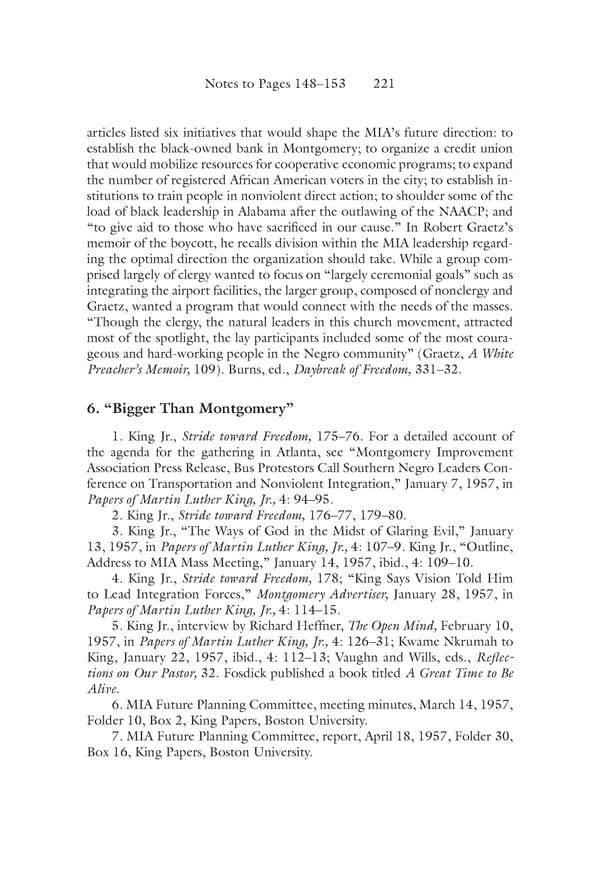Notes to Pages 148–153 221 articles listed six initiatives that would shape the MIA’s future direction: to establish the black-owned bank in Montgomery; to organize a credit union that would mobilize resources for cooperative economic programs; to expand the number of registered African American voters in the city; to establish in- stitutions to train people in nonviolent direct action; to shoulder some of the load of black leadership in Alabama after the outlawing of the NAACP; and “to give aid to those who have sacrificed in our cause.” In Robert Graetz’s memoir of the boycott, he recalls division within the MIA leadership regard- ing the optimal direction the organization should take. While a group com- prised largely of clergy wanted to focus on “largely ceremonial goals” such as integrating the airport facilities, the larger group, composed of nonclergy and Graetz, wanted a program that would connect with the needs of the masses. “Though the clergy, the natural leaders in this church movement, attracted most of the spotlight, the lay participants included some of the most coura- geous and hard-working people in the Negro community” (Graetz, A White Preacher’s Memoir, 109). Burns, ed., Daybreak of Freedom, 331–32. 6. “Bigger Than Montgomery” 1. King Jr., Stride toward Freedom, 175–76. For a detailed account of the agenda for the gathering in Atlanta, see “Montgomery Improvement Association Press Release, Bus Protestors Call Southern Negro Leaders Con- ference on Transportation and Nonviolent Integration,” January 7, 1957, in Papers of Martin Luther King, Jr., 4: 94–95. 2. King Jr., Stride toward Freedom, 176–77, 179–80. 3. King Jr., “The Ways of God in the Midst of Glaring Evil,” January 13, 1957, in Papers of Martin Luther King, Jr., 4: 107–9. King Jr., “Outline, Address to MIA Mass Meeting,” January 14, 1957, ibid., 4: 109–10. 4. King Jr., Stride toward Freedom, 178; “King Says Vision Told Him to Lead Integration Forces,” Montgomery Advertiser, January 28, 1957, in Papers of Martin Luther King, Jr., 4: 114–15. 5. King Jr., interview by Richard Heffner, The Open Mind, February 10, 1957, in Papers of Martin Luther King, Jr., 4: 126–31; Kwame Nkrumah to King, January 22, 1957, ibid., 4: 112–13; Vaughn and Wills, eds., Reflec- tions on Our Pastor, 32. Fosdick published a book titled A Great Time to Be Alive. 6. MIA Future Planning Committee, meeting minutes, March 14, 1957, Folder 10, Box 2, King Papers, Boston University. 7. MIA Future Planning Committee, report, April 18, 1957, Folder 30, Box 16, King Papers, Boston University.
 Becoming King: Martin Luther King Jr. Page 241 Page 243
Becoming King: Martin Luther King Jr. Page 241 Page 243